No Knead Bread
This classic no knead bread recipe from Jim Lahey is easy, requires minimal handling, and is a great recipe for beginner bread bakers.
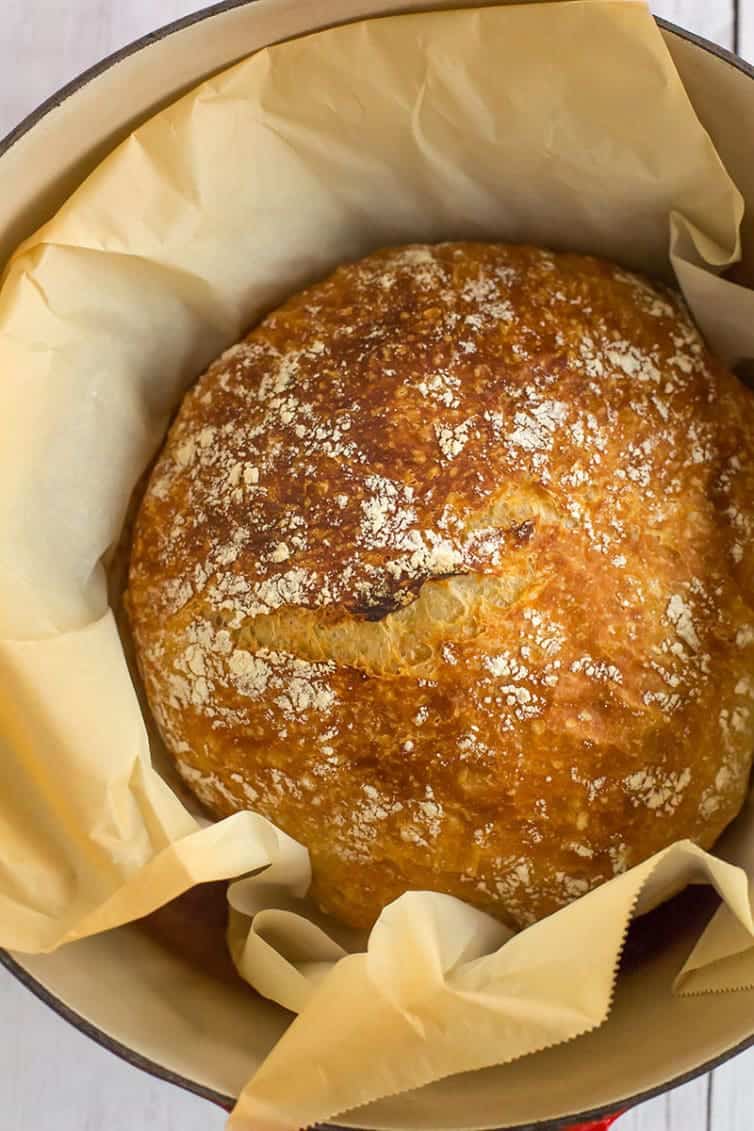
Have you hopped on the no knead bread train yet?
After seeing it in countless places over the years, I finally dove in this week and gave it a try. With hardly any hands-on time and quite forgiving rise times, it seemed to be the perfect bread recipe for squeezing into bedtime and nap schedules.
When I first started researching no knead bread recipes, I found that “THE” recipe recommended by throngs of bakers is the version by Jim Lahey. It was published in the New York Times by Mark Bittman, and after reading through hundreds of comments with suggestions, modifications and variations, off I went!
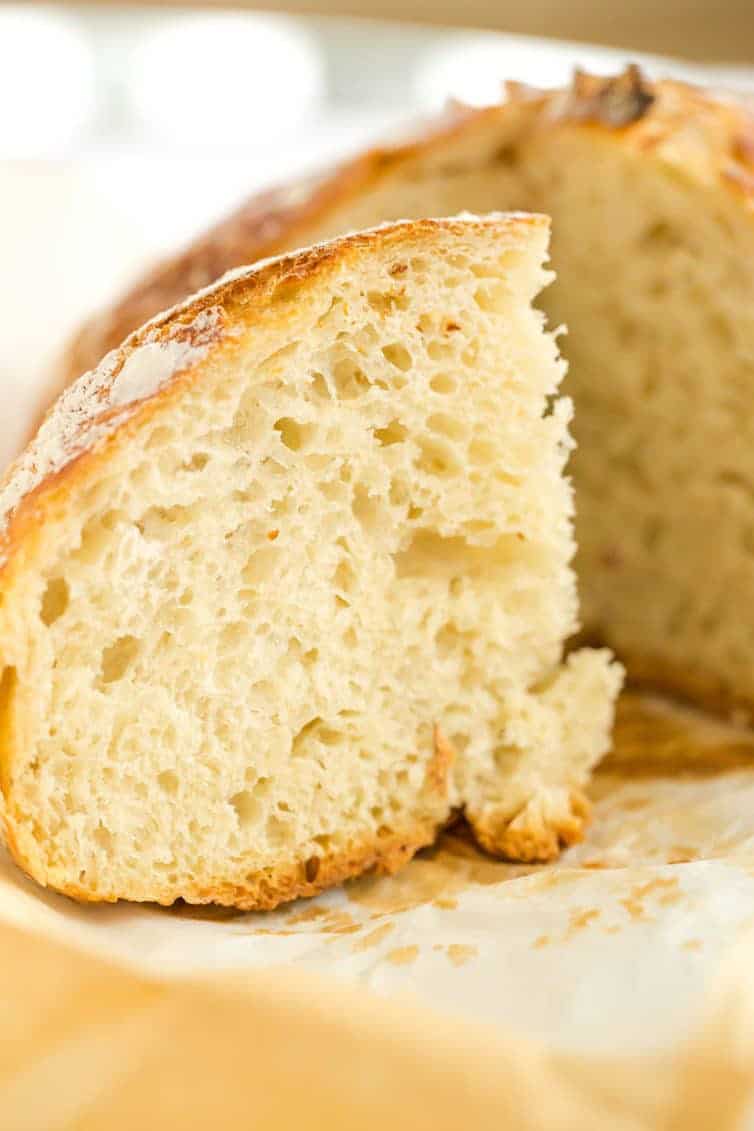
This recipe requires two rise times, but the first is a very long one – the dough should rest for at least 12 hours, ideally up to 18 hours. I mixed together the dough (less than 10 minutes!) and started this rise around 7:30pm after the boys were in bed, and let it go until about 10:30am the next morning.
Ready to go after 15 hours:
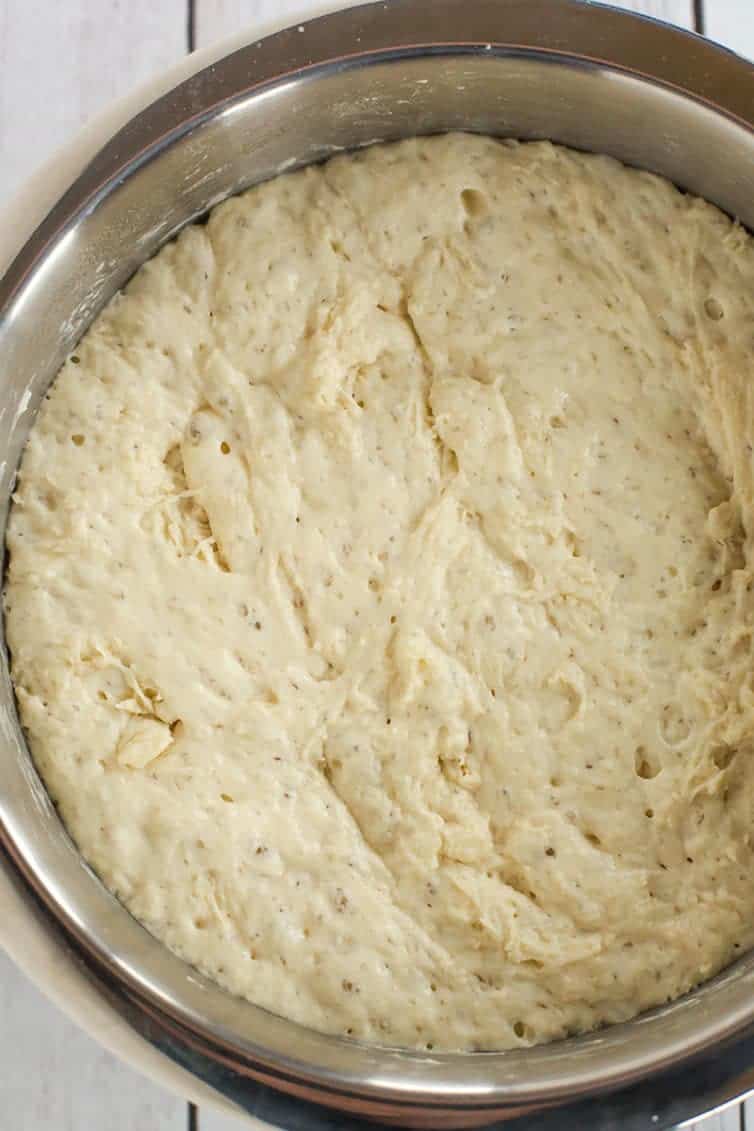
Since there isn’t much hands-on work necessary with this recipe, all you do is turn the dough out onto a floured surface and fold it over itself a couple of times, let it rest for 15 minutes, then give it a quick shape into a ball, and let it go for its final rise.
The original recipe calls for placing the dough on a floured towel for its final rise, then kind of flipping it into the Dutch oven for baking.
(Sidenote: I adore any recipe that allows me to bust out one of my favorite kitchen vessels – my beloved Dutch oven!)
After reading through a ton of comments, I decided instead to line a bowl with parchment paper, let the dough do its final rise in there, and then simply lift it out and place it in the heated Dutch oven using the parchment paper to transfer it. So much easier and a decreased risk of getting burned in the process!
Save This Recipe
This was the dough ready to head into the Dutch oven for baking:
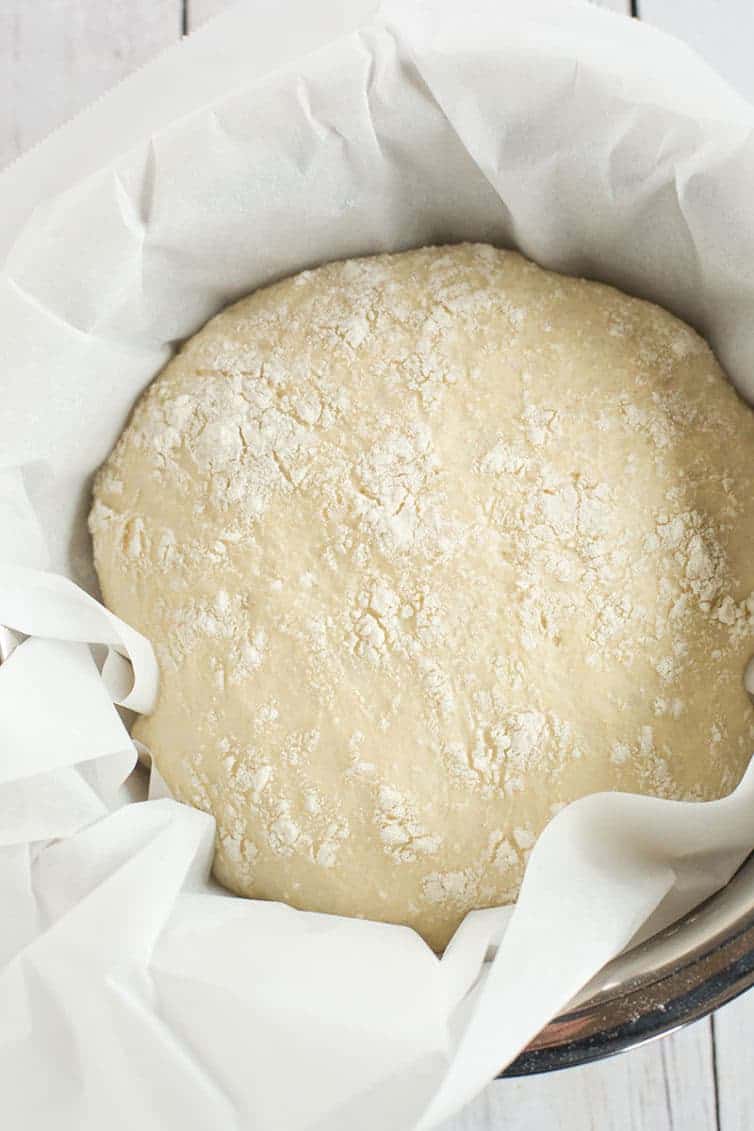
The result?
A gorgeous loaf of artisan-style bread that required about 15 minutes, MAX, of hands-on time. You absolutely, positively, cannot beat that!
While I have an all-time favorite white bread recipe (there is always a sliced loaf in our freezer), this no knead bread, with its crisp crust and soft, airy crumb, is the perfect bread for dunking in soup, stew or chili, or slathering with butter for an afternoon snack.
After waiting all of this time to make it, no knead bread officially has a spot on my short list of favorite bread recipes!
Watch How to Make No Knead Bread:
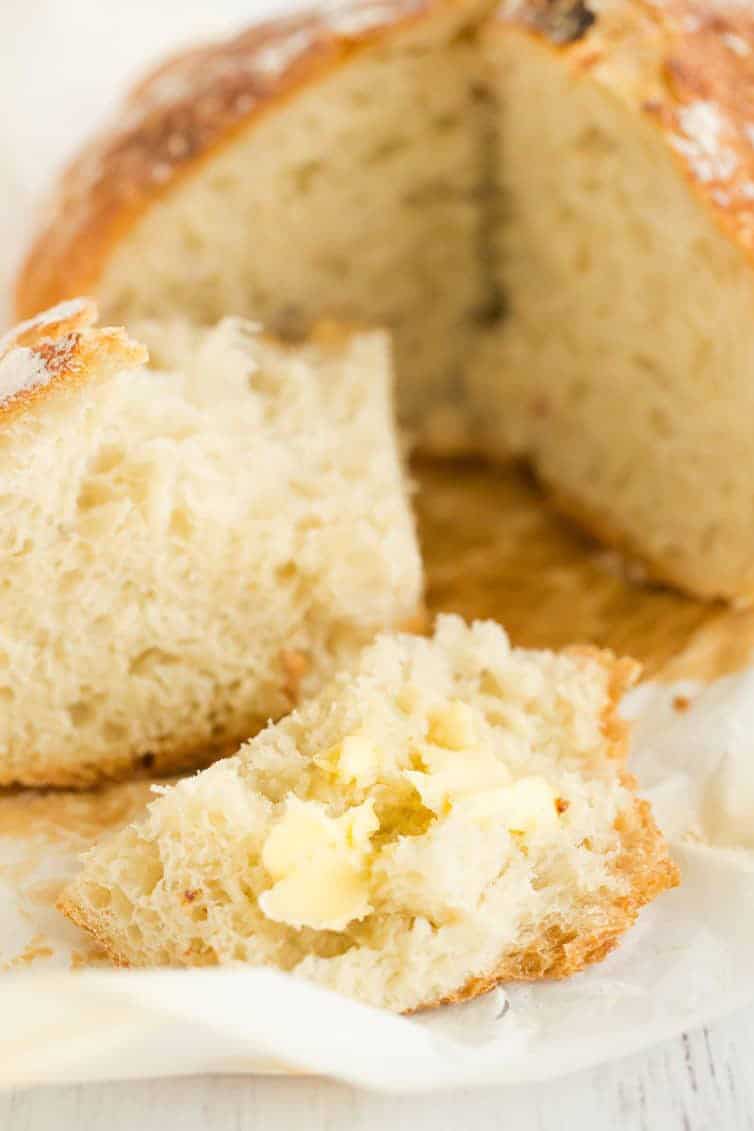
More Favorite Bread Recipes
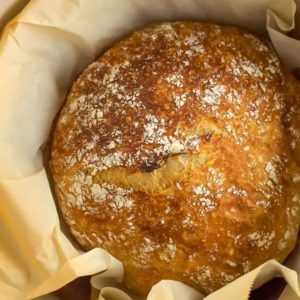
No Knead Bread
Ingredients
- 3 cups (375 g) all-purpose flour
- ¼ teaspoon (0.25 teaspoon) instant yeast
- 1½ teaspoons (1.5 teaspoons) salt
- 1½ cup (350 ml) + 2 tablespoons water
Instructions
- In a large bowl, stir together the flour, yeast and salt. Add the water and stir together with a wooden spoon until all of the flour is moistened (the dough will be quite shaggy). Cover the bowl with plastic wrap and let rest at warm room temperature for 12 to 18 hours.
- The dough will be ready when the surface is covered in small bubbles. Lightly flour a work surface and turn the dough out onto it; sprinkle it with a little more flour and fold the dough over onto itself twice. Cover loosely with plastic wrap and let sit for 15 minutes.
- Using enough flour necessary to keep the dough from sticking to the work surface or your fingers, quickly shape the dough into a ball. Place a sheet of parchment paper in a large bowl, and place the ball of dough onto the parchment paper. Dust the top of the bread with additional flour and cover with a clean kitchen towel. Allow the dough to rise until it has more than doubled in size and it does not immediately spring back when poked with a finger, about 2 hours.
- At least 30 minutes before the dough will be ready, place a large 6 to 8-quart Dutch oven in the oven and preheat to 450 degrees F.
- When the dough is ready, lift the edges of the parchment from the bowl and carefully transfer it into the heated Dutch oven. Cover with a lid and bake for 30 minutes. Remove the lid and continue to bake for an additional 15 to 30 minutes, or until a deep golden brown. Cool on a wire rack; serve warm or at room temperature.
Notes
- You can substitute bread flour for a denser, chewier loaf of bread.
Did you make this recipe?
Leave a review below, then snap a picture and tag @thebrowneyedbaker on Instagram so I can see it!


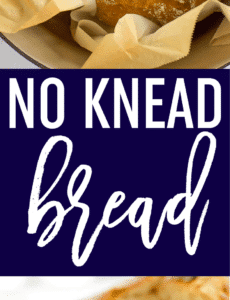



I reduced the temp to 400 and cut the baking time by 15 minutes but the bottom still burns. What an I doing wrong?
This is so easy and delicious! Question – I add chia seeds (12 tbsp). Should I increase the amount of water used in the recipe?
very, very, good. will do it again
Loved how Easy this was to Make and How Much we Enjoyed it with soup!
Michelle,
This question may be out of place, but I would appreciate your comment. I have been making a 100% whole wheat bread. Thew recipe calls for a 1/4 cup of honey. I prefer a slightly sweeter loaf. If I use 1 full cup of honey, what other alterations do I need to make?
Thank you
Jim Stecher
I would love to make the no knead bread. But, I’m allergic to gluten and wheat. I have my flour that I can substitute cup for cup so that is not the problem. The problem is with the 2 risings. Because with gluten free bread it can only go through one rising. You mix your dough, shape it and let it rise. How long would I have to let it rise for it to turn out right? Would it be the first rising or the second?
Thank you for your help ❤️
Hi Amanda, I’ve never used gluten free flour for bread, so I can’t guarantee the results, but I would eliminate the 2nd rise and just shape it into a ball and let it sit for maybe 15 to 30 minutes before baking.
I made the Milk Bread recipe over and over. So awesome. I also made cinnamon rolls with part of it and I made sandwich buns. My son never wants store-bought again! As to this recipe, can I substitute bread flour for all-purpose? What difference would it make?
I wonder if there is reason for a 30 minute autolyse with this. I am a big fan of holding off on the salt til the last minute before proofing.
I just received a beautiful Staub Dutch oven I’ve had my eye on and plan to make your bread. I’ve read I risk the enamel cracking by putting the Dutch oven into the preheating oven empty. I see lots of people having success with their Dutch ovens. Have you heard of or experienced this? Thank you.
Hi Karen, I use a Staub Dutch oven for my no-knead bread and haven’t run into any issues yet, and I make it every 3 days or so (it’s my husband’s favorite!).
I have renamed this “Quarantine Bread” since I have been making it every third day or so for the past month! For those wanting to add whole wheat flour, I have successfully made it subbing 1 cup of white whole wheat flour for 1 cup of the all purpose flour. To help with the rise I upped the yeast to 1 tsp and added 1 tbsp vital wheat gluten. Since I use kosher salt, I use 2 tsp instead of 1.5 tsp. I also like adding a tblsp of honey to the hot water. I have brushed it with a mixture of evoo and milk then sprinkled with either sesame seeds and/or gray sea salt or everything bagel seasoning just before putting it in the oven. I also score an “X” on top before baking. If you don’t have a Le Creuset dutch oven, any oven-safe vessel with a lid will work just fine. A friend of mine shapes her dough into an oblong and uses one of those old timey blue speckled enameled roasting pans that our grandmas used to roast the turkey in!
How amazing is this recipe? I live making bread but the kneading part is laborious and I’m lazy. I love it! It’s such a lovely fresh loaf too. Well done and thank you.
Alton Brown covered this in his “Going Dutch” episode. Few changes but essentially the same. Only alteration I usually make is to hold back a little water and the salt and do a 20 minute autolyze. According to Peter Reinhart it yields a smoother texture and softer crumb. Not sure it makes a real big difference but it helps give a more consistent result.
I am writing from the UK. When baking bread we would normally use strong white flour. Our softer flours are self-raising (plain flour but including a raising agent) that would typically use for baking sponges etc., and plain flour. So, my question is – what is all purpose flour and can I substitute strong (bread-making flour)?
Do I need to cover with plastic wrap to rise?
This is a great recipe….Thank you! I have made this successfully a number of times. However, being older, I must admit that my Dutch oven is becoming difficult for me to lift safely. Having read about a cold oven start for this bread, I was wondering if you think it would work with your recipe. At least I’d only have to worry about lifting a screaming hot pot
once in the baking process. Would appreciate your thoughts. Thanks again for a wonderful recipe! 5 Stars at least!
Recipe worked perfectly. I used a large Correlle casserole with a lid because I didn’t have my LeCruset. Worked just fine. Delicious bread that made the house smell wonderful!
I’ve made several versions of this bread. Kalamata olives, craisins or other dried fruits, different cheeses, All yummy! Now I’d like to use some sourdough starter. Any suggestion as to how I need to adjust the recipe? Thank you.
Hi Cherie, I haven’t worked with a sourdough starter myself, but this recipe looks good! –> https://holycowvegan.net/no-knead-sourdough-bread/